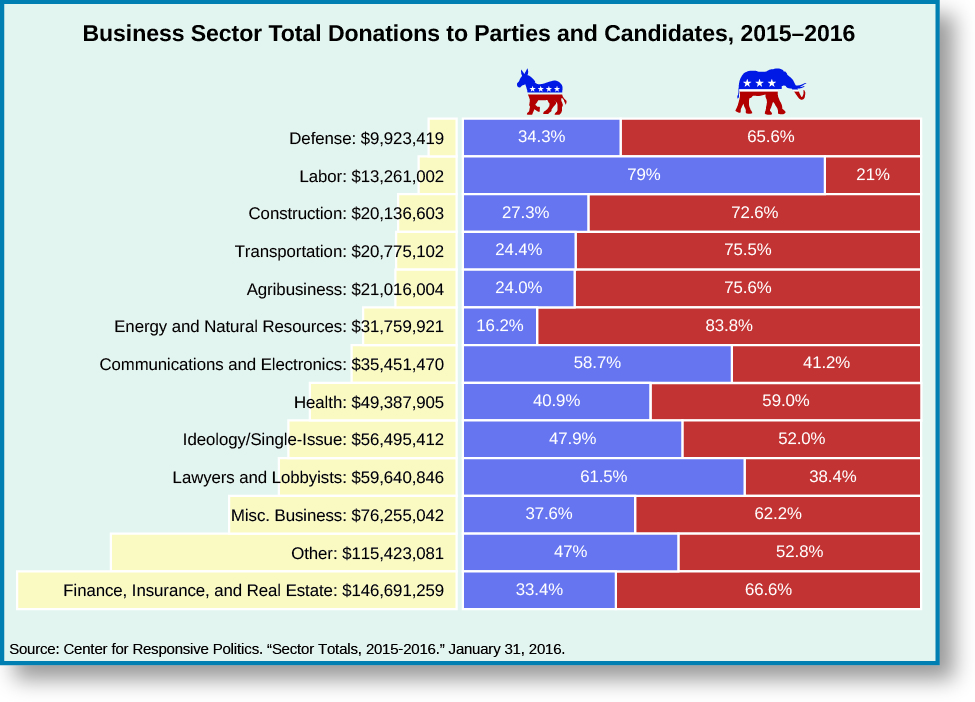| << Chapter < Page | Chapter >> Page > |
[link] shows contributions by interests from a variety of different sectors. We can draw a few notable observations from the table. First, large sums of money are spent by different interests. Second, many of these interests are business sectors, including the real estate sector, the insurance industry, businesses, and law firms.

Interest group politics are often characterized by whether the groups have access to decision-makers and can participate in the policy-making process. The
iron triangle is a hypothetical arrangement among three elements (the corners of the triangle): an interest group, a congressional committee member or chair, and an agency within the bureaucracy.
An alternate explanation of the arrangement of duties carried out in a given policy area by interest groups, legislators, and agency bureaucrats is that these actors are the experts in that given policy area. Hence, perhaps they are the ones most qualified to process policy in the given area. Some view the iron triangle idea as outdated. Hugh Heclo of George Mason University has sketched a more open pattern he calls an
issue network that includes a number of different interests and political actors that work together in support of a single issue or policy.
Some interest group scholars have studied the relationship among a multitude of interest groups and political actors, including former elected officials, the way some interests form coalitions with other interests, and the way they compete for access to decision-makers.
While most scholars agree that some interests do have advantages, others have questioned the overwhelming dominance of certain interests. Additionally,
neopluralist scholars argue that certainly some interests are in a privileged position, but these interests do not always get what they want.
A good example is the recent dispute between fast food chains and their employees. During the spring of 2015, workers at McDonald’s restaurants across the country went on strike and marched in protest of the low wages the fast food giant paid its employees. Despite the opposition of restaurant chains and claims by the National Restaurant Association that increasing the minimum wage would result in the loss of jobs, in September 2015, the state of New York raised the minimum wage for fast food employees to $15 per hour, an amount to be phased in over time. Buoyed by this success, fast food workers in other cities continued to campaign for a pay increase, and many low-paid workers have promised to vote for politicians who plan to boost the federal minimum wage.
Visit the websites for the California or Michigan secretary of state, state boards of elections, or relevant governmental entity and ethics websites where lobbyists and interest groups must register. Several examples are provided but feel free to examine the comparable web page in your own state. Spend some time looking over the lists of interest groups registered in these states. Do the registered interests appear to reflect the important interests within the states? Are there patterns in the types of interests registered? Are certain interests over- or underrepresented?
Interest groups afford people the opportunity to become more civically engaged. Socioeconomic status is an important predictor of who will likely join groups. The number and types of groups actively lobbying to get what they want from government have been increasing rapidly. Many business and public interest groups have arisen, and many new interests have developed due to technological advances, increased specialization of industry, and fragmentation of interests. Lobbying has also become more sophisticated in recent years, and many interests now hire lobbying firms to represent them.
Some scholars assume that groups will compete for access to decision-makers and that most groups have the potential to be heard. Critics suggest that some groups are advantaged by their access to economic resources. Yet others acknowledge these resource advantages but suggest that the political environment is equally important in determining who gets heard.

Notification Switch
Would you like to follow the 'American government' conversation and receive update notifications?